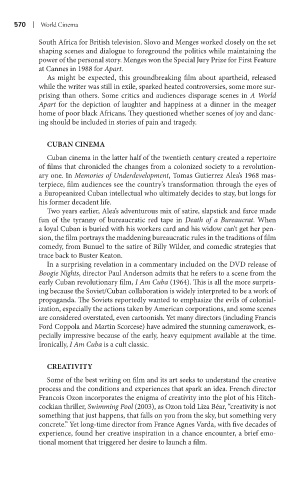Page 591 - Battleground The Media Volume 1 and 2
P. 591
0 | World C nema
South Africa for British television. Slovo and Menges worked closely on the set
shaping scenes and dialogue to foreground the politics while maintaining the
power of the personal story. Menges won the Special Jury Prize for First Feature
at Cannes in 1988 for Apart.
As might be expected, this groundbreaking film about apartheid, released
while the writer was still in exile, sparked heated controversies, some more sur-
prising than others. Some critics and audiences disparage scenes in A World
Apart for the depiction of laughter and happiness at a dinner in the meager
home of poor black Africans. They questioned whether scenes of joy and danc-
ing should be included in stories of pain and tragedy.
CuBan CinEma
Cuban cinema in the latter half of the twentieth century created a repertoire
of films that chronicled the changes from a colonized society to a revolution-
ary one. In Memories of Underdevelopment, Tomas Gutierrez Alea’s 1968 mas-
terpiece, film audiences see the country’s transformation through the eyes of
a Europeanized Cuban intellectual who ultimately decides to stay, but longs for
his former decadent life.
Two years earlier, Alea’s adventurous mix of satire, slapstick and farce made
fun of the tyranny of bureaucratic red tape in Death of a Bureaucrat. When
a loyal Cuban is buried with his workers card and his widow can’t get her pen-
sion, the film portrays the maddening bureaucratic rules in the traditions of film
comedy, from Bunuel to the satire of Billy Wilder, and comedic strategies that
trace back to Buster Keaton.
In a surprising revelation in a commentary included on the DVD release of
Boogie Nights, director Paul Anderson admits that he refers to a scene from the
early Cuban revolutionary film, I Am Cuba (1964). This is all the more surpris-
ing because the Soviet/Cuban collaboration is widely interpreted to be a work of
propaganda. The Soviets reportedly wanted to emphasize the evils of colonial-
ization, especially the actions taken by American corporations, and some scenes
are considered overstated, even cartoonish. Yet many directors (including Francis
Ford Coppola and Martin Scorcese) have admired the stunning camerawork, es-
pecially impressive because of the early, heavy equipment available at the time.
Ironically, I Am Cuba is a cult classic.
CrEaTiviTy
Some of the best writing on film and its art seeks to understand the creative
process and the conditions and experiences that spark an idea. French director
Francois Ozon incorporates the enigma of creativity into the plot of his Hitch-
cockian thriller, Swimming Pool (2003), as Ozon told Liza Béar, “creativity is not
something that just happens, that falls on you from the sky, but something very
concrete.” Yet long-time director from France Agnes Varda, with five decades of
experience, found her creative inspiration in a chance encounter, a brief emo-
tional moment that triggered her desire to launch a film.

